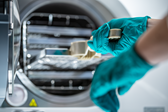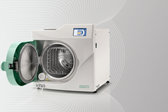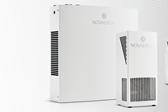Categories
Most Recent
Ventilation in practice: is it enough?
3rd Oct 2021 in Dental, Animal Health, HealthcareIt's now well understood that air quality inside dental practices is something that should be taken into consideration. The pandemic has put airborne transmission of diseases into the spotlight, and this has meant that individuals throughout the healthcare industry have now started to explore methods to help prevent airborne transmission in their places of business.
Ventilation, in particular, has become a recommended measure. The Centre for Diseases and Control (CDC) has suggested that ‘protective ventilation practises and interventions can reduce the airborne concentrations and reduce the overall viral dose to occupants’[i] in settings. But is ventilation alone enough?
Airborne transmission and what we know
Airborne transmission of pathogens is a more complex route of transmission than you would originally imagine. Once a pathogen is expelled into the air, there are various factors that can impact how long that it is likely to remain suspended as an airborne threat.
For example, the size of droplets expelled into the air makes a considerable difference. Heavier, larger droplets may be able to travel quite far, but they inevitably fall on to surfaces fairly quickly. Miniscule droplets, such as aerosol, are far more difficult to predict.
Aerosol droplets are typically those that are less than 5 μm (micrometres), meaning that they are extremely small. As such, these droplets can remain suspended in air for longer and, according to research, may even pose more risk to those breathing them in, as they are easier to breathe deep into the lungs. [ii] There is also research to suggest that infectious droplets in aerosol form may be able to travel further than two metres – the distance that has been the foundation of social distancing throughout the pandemic.[iii]
With regards to COVID-19, in particular, there has been suggestion that unlike some other diseases that can travel fair distances in an airborne state (measles, tuberculosis) it is more likely to be an “opportunistically” airborne pathogen, meaning that it is feasibly more of a threat in enclosed spaces where there are multiple people.[iv]
Looking at these factors, it becomes clear that airborne transmission is not to be underestimated, especially in areas where ventilation is poor.
Barriers to ventilation
Due to aerosol generating procedures creating pathogenic fusions of blood, saliva, plaque, tooth debris and gum secretions, dental practices are likely to have a number of potentially infectious particles in the air.
While windows and other engineered ventilation methods do help with lowering the risk, due to the existing architecture of dental practices, a good standard of ventilation isn’t always possible. Air flows throughout indoor spaces as well, meaning that even if you do have some areas that are properly ventilated, you can’t guarantee consistent good air quality throughout the building.
Air quality within a dental practice is also constantly changing. As more procedures are performed and new patients enter and exit, the chances of the air becoming contaminated with pathogens increases throughout each clinical session. Even one patient carrying a disease can become a source of airborne pathogens, and with most practices seeing a high number of patients each day, this is a threat that can’t be ignored.
When you think about these factors, it becomes clear that ventilation alone isn’t a fool proof measure. So, what can you do to help ensure air quality in your practice remains safe for all?
Invest in an air disinfection system
Air disinfection systems are a reliable way to ensure excellent air quality and defend against airborne transmission. Of course, with many different systems on the market, it’s a smart idea to compare the proven capabilities of these pieces of technology and find one that is suitable for your individual needs. This includes looking at the method in which they disinfect the air, the scientific evidence, their running costs, environmental impact such as noise pollution and volatile organic compound emissions (VOCs), and how efficient they are at providing a high standard of protection.
One excellent option for dental practices is the Novaerus air disinfection units available from Eschmann. Scientifically proven, the Novaerus air disinfection units use patented NanoStrike plasma technology that safely kills and deactivates all airborne microorganisms on contact, providing the first line of protection against viruses and bacteria. With no harmful by-products, Novaerus plasma technology is safe for continued 24/7 use around even the most vulnerable.
Air quality is now a top priority
With a focus on air quality becoming the norm, now is the time to ensure that you can offer your patients and staff peace of mind. While a good standard of ventilation is a step forward in the right direction, for increased certainty it pays to invest in a proven air disinfection device – especially one that can offer continuous protection.
For more information please contact us or view Novaerus air disinfection here.
[i] Centers for Disease Control and Prevention. Ventilation in Buildings. Read more
[ii] Jayaweera, M. et al. Transmission Of COVID-19 Virus By Droplets and Aerosols: A Critical Review On The Unresolved Dichotomy. Environ Res. 2020 Sep; 188: 109819.
[iii] British Medical Journal. Two Metres or One: What Is The Evidence For Physical Distancing in Covid-19? Read more
[iv] Science Media Centre. Expert Reaction To Commentary About Potential Airborne Transmission Of The SARS-COV-2 Virus. Read more









